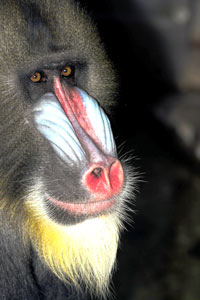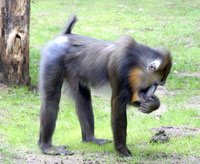|


More colorful when excited: The Mandrill is recognized by its olive-colored fur and colorful face and rump amongst males, a coloration that grows stronger with sexual maturity; females have duller colors. This coloration becomes more pronounced as the monkey becomes excited. The coloration on the rump is thought to enhance visibility in the thick vegetation of the rainforest and aids in group movement.
Much bigger males: Males can weigh up to 60 lb (30 kg), females about half as much. They can grow to be about 1 m long (39 in) and can survive up to 25 years in captivity. Females reach sexual maturity at about 3.5 years.

Led by a dominant male: The mandrill is found in the tropical rainforests of West Africa (Southern Nigeria, South Cameroon, Gabon, and Congo). It is a social creature and may be found in groups ranging from 5 to 50 individuals, led by an older dominant male. Six to seven of these groups may come together during the dry season to form a troop of over 200 individuals.
 Foraging endangered omnivores: The mandrill is an omnivore and acquires its food by foraging (mainly plants, insects and smaller animals) from the ground as it is terrestrial, although it may climb trees occasionally to sleep. Its main natural predators are leopards and cheetahs. Because of over-hunting by humans, the mandrill has become endangered. The situation is exacerbated by deforestation causing Mandrill habitats to disappear. Foraging endangered omnivores: The mandrill is an omnivore and acquires its food by foraging (mainly plants, insects and smaller animals) from the ground as it is terrestrial, although it may climb trees occasionally to sleep. Its main natural predators are leopards and cheetahs. Because of over-hunting by humans, the mandrill has become endangered. The situation is exacerbated by deforestation causing Mandrill habitats to disappear.
Don't mess with a Mandrill: Although the Mandrill does not normally hunt larger prey, on some occasions males have been observed to hunt and consume duiker (a small antelope). Despite this it is well adapted to fighting and is not to be provoked.

The gestation (pregnancy) time for the Mandrill is 6–7 months and young are usually born between January and April. However, the mandrill mates throughout the year during the estrus cycle, which occurs once every 33 days. The interbirth interval is typically 13-14 months.
Pink-skinned babies: Mandrill infants are born with their eyes open and with fur. They have a black coat and pink skin for the first two months. They cling to their mother's belly immediately and can support their own weight. Mothers form bonds with their children. These bonds last into adulthood with the daughters, while the bonds with the sons last only until his sexual maturity. These bonds entail the two sitting with each other and grooming each other.
Baboon | Howler Monkey | Lion Tamarin| Marmoset | Patas Monkey | Squirrel Monkey
Primates| Apes| Monkeys| Prosimians
All text is available under the terms
of the GNU Free Documentation License
|